 I recently returned from walking Spain’s famed Camino de Santiago pilgrimage route. I am proud, delighted and relieved to share that I successfully completed my “half Camino” – walking for 19 days over 230 miles with my trusty 20# backpack to arrive in the destination city of Santiago de Compostela.
I recently returned from walking Spain’s famed Camino de Santiago pilgrimage route. I am proud, delighted and relieved to share that I successfully completed my “half Camino” – walking for 19 days over 230 miles with my trusty 20# backpack to arrive in the destination city of Santiago de Compostela.
Walking the Camino was a wonderful experience, just as I hoped it would be! The scenery of northern Spain was beautiful and I met so many wonderful people – from the friendly locals (in hostels, cafes, and shops) to my fellow pilgrims, who were from all around the globe. It truly was a grand adventure that I feel so blessed to have experienced.
Before I left, I wrote a blog post entitled “My Upcoming Camino Pilgrimage” – explaining all about the Camino de Santiago, what I ‘thought’ it might be like, and answered the most common FAQs. Just like I did in the Pre-Camino post, I am providing this Post-Camino update in an easy-to-read FAQ format.
What is the Camino de Santiago & Camino Francés?
The Camino de Santiago or the “Way of St. James” is a medieval Christian pilgrimage route. For almost a thousand years, it brought pilgrims from all corners of Europe to the city of Santiago de Compostela. There, the magnificent cathedral is believed by many to be the final resting place of the Apostle St. James!
There are quite a few different Camino de Santiago routes (see map) but the most popular is the Camino Francés (or “French Way”). Traditionally, it starts in the French town of St. Jean Pied de Port, which is 776 km (482 miles) from Santiago. It crosses the Pyrenees, soon arriving into Spain. The Camino Francés is the route featured in the popular 2011 movie “The Way” starring Martin Sheen. It was filmed on location along the Camino. (more info in the original post)
How Far Did You Walk Each Day?
I began my walk in the town of Sahagun, known as the “half way” point of the Camino Francés. It took me 19 days to walk the ~ 230 miles (380 kilometers) to Santiago, averaging 20 km/day (12 miles). My distances ranged from “short days” of 14-15 km (9 miles) to a high of 25-27 km (15-16 miles). I walked between 4 – 6.5 hours (average of 5.5 hours) each day. In addition, my rest & food breaks added an average of 1 ¼ hours more – so I averaged around 7 hours in my hiking boots each day.
How Was the Scenery? What was the Camino Path Like?
The landscape along the Camino Francés was just beautiful and filled with great variety. For example, the Camino path took us on rocky hiking trails through stately forests; onto quiet country roads which passed through small villages, corn fields, and cow pastures; and alongside main roads on tree-lined gravel paths. There was an interesting mix of flats, gentle rolling hills, and some “fun” up and down mountains. I never found it boring.
The constant hunt for the Camino signposts (road signs, concrete monuments) and painted yellow arrows (on every imaginable surface) marking the route certainly added to the walk’s fun and challenge. The Camino was mostly well-marked but there were quite a few times when it was definitely a hunt – particularly in some of the larger towns and cities. Luckily, I never got too far afield thanks to friendly locals and other pilgrims who helped me “find the way!”
How Was the Weather?
I was blessed with good weather, since I was traveling at an optimum time (mid-September to early October). Early mornings were cool as I started my walk (occasionally upper 40s to mostly low-mid 50s) but it soon warmed to a mid-day temperature in the 60s and low 70s. I encountered some rain before I started my walk (in Madrid and Leon) but no more until my final Camino day – when I walked my final three hours into Santiago under light sprinkles. In addition, there were a couple instances of heavy fog (for a short period) in the Galicia region. Bottom line – I was lucky.
Who Were Your Fellow Pilgrims?
As expected, I met lots of Europeans (Spain, Germany, Italy, France, UK, Ireland) as well as many Americans, Canadians, Australians, Brazilians and South Koreans. Other “Camino friends” were from New Zealand, Denmark, Holland, Belgium, Poland, South Africa and Columbia (South America). It was definitely a fascinating United Nations mix.
As for “travel groups,” there were many solo travelers like me – perhaps a quarter to a third of the pilgrims I saw. There were married couples and many sets of good friends walking together, and other family units that I met – like two mothers with their adult sons, five Brazilian sisters, and a young Brazilian woman traveling with her mom and aunt. Pilgrims were all ages, and I was delighted to see that a significant amount were “older” like me (in their 50s, 60s, and early 70s).
- Kate – my new pilgrim friend
What Was a Typical Pilgrim Day Like?
I awoke around 6:30am, got ready and packed my backpack. I usually had breakfast at or near my lodging – tea or coffee, orange juice and toast (or a pastry). I was surprised to learn at this time of year that the sunrise wasn’t until after 8am. So, I generally began to walk around 8:15am as it was just getting light. Personally, I didn’t like walking in the early morning darkness – as many pilgrims did (with their headlamps). Some “early birds” would even leave at 5:30-6:00am – definitely not me!
After walking for around 2 hours, I would stop at a café (usually filled with other pilgrims) for a snack and bathroom break – ordering café con leche, another fresh-squeezed orange juice and a chocolate-filled croissant. Depending on the length of the walk that day, there might be other breaks along the way – always for food! – before arriving at the day’s destination town and my lodging.
After checking into my pilgrim hostel (usually between 1-4pm) and getting my bunk bed assignment, I would unpack and head off to the shower. Once happily clean and in fresh clothes, I would find the laundry area to hand wash that day’s hiking clothes (blouse, underwear and socks) since I only had two pairs of each. Then it was outside to hang my laundry in the sun on the hostel’s clothes line or drying racks. Once these daily rituals were done, I might journal, go out in search of immediate food (if I hadn’t stopped for lunch), or shop at the local pharmacy or market. Then I would explore the town – if it was large enough to have things to see (as many did!).
- Leon Cathedral
- Knights Templar Castle- Ponferrada
- Bishop’s Palace (by Gaudi) – Astorga
Between 7-8pm, it was time for dinner. My hostels often had a café/ restaurant where I would usually eat. If not, I would head into the center of town to look for a restaurant that offered a pilgrim menu, often meeting up with some Camino friends. Then it was back to the hostel by 9-9:30pm to get ready for bed before the 10-10:30pm lights out. I would often stay up later (in a different room) to finish my journaling or Facebook post before sneaking back into the dark dorm room to quietly crawl into my sleeping bag for a good night’s sleep.
How Was Your Lodging / The Pilgrim Hostels?
I usually stayed in “pilgrim hostels” (called albergues) where I slept in coed dorm rooms filled with bunk beds. The cost generally ranged from 5-10 euros / night. I was pleasantly surprised at this type of “communal living” experience – it wasn’t too bad and was actually fun. My “industrial strength” silicone earplugs (and the occasional Ambien sleeping pill) helped with any nearby loud snorers.
I really liked all of my albergues – each one was quite different which made it interesting. They were well organized for our pilgrim needs – including providing areas for washing and drying your clothes. Many had cafe/restaurants where you could get breakfast and/or dinner for an additional fee. Some of them had lovely gardens and lawns for relaxing during the afternoon and early eves (it didn’t get dark until around 8-8:30pm.)
A few of the nights (especially later on), I “upgraded” to an individual room at an albergue or a pension (one level down from a hotel) for between 25-38 euros. They came with either an ensuite or shared bathroom with one other room. It was heaven to have real bath towels and “no lights out” time constraints – such as the need to pack your backpack in the morning in the dark (with your headlamp).
- My pension in Pedrouzo for 25 euros/night (with shared bath) including breakfast. My nice room – middle photo. Far right is my pension – Casa Curro – in Palas de Rei.
I enjoyed experiencing the wide range of lodging options for pilgrims offered by the Camino’s towns and villages. However, my initial plan to show up each afternoon in a town without reservations and see what hostel struck my fancy didn’t quite pan out. September turned out to be quite a busy time on the Camino with lots of pilgrims (and many full albergues by mid-afternoon) so I felt safer booking much of my lodging ahead (either that same day or one day in advance).
How Did Your Backpack Work Out? Are You Still Friends?
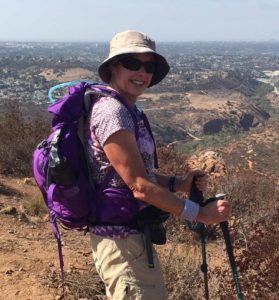
However, it turned out that my 20# backpack (9kg) was relatively the norm on the Camino. Luckily, it was comfortable – and the weight seemed fine for my body. Amazingly, I never had a sore back or shoulders. In part, this may be thanks to my yoga and swim practice.
How Did Your Feet & Body Handle the Camino?
As experienced pilgrims say, it’s ALL about the feet! Our feet (and legs) certainly take the brunt of all those miles of walking. Blisters and tendonitis (of the lower leg like Achilles and shin splints) are common pilgrim complaints. Apparently, walking too far and too fast really contribute to these nasty problems. Knowing this, I made sure to “take it easy” on both counts all along the way – and it clearly paid off.

Taking off the boots as soon as I arrived at the hostel (and putting on my sandals) felt so good! Luckily, after a good night’s sleep, my feet and legs were ready to hit the trail once again. I truly feel fortunate that my body was able to handle the rigors of the Camino so well. I must also give a big shout out to my 3 times daily doses of ibuprofen (Advil) for its anti-inflammatory properties.
Many of my Camino friends (above) were not quite so lucky. Many had nasty blisters at least once but they persevered. Pilgrims become experts at blister care. Other friends dealt with shin splints and/or bad knees or ankles. But getting taped up, wearing knee braces, seeing local physiotherapists for treatments, and taking rest days were some of the strategies that kept them all going. The spirit of a determined pilgrim is a beautiful thing to watch!
How Was the Food?
The quality of the “pilgrim food” was another nice surprise. I ate quite well – and a lot! We pilgrims really burn up the calories so there was no guilt in having that large chocolate croissant on my morning coffee break and a dessert each night with my “pilgrim dinner.”
Most of my albergues, as well as many of the local restaurants, served a reasonably priced (usually 9-10€) “pilgrim menu.” The menu included three courses – choice of a starter (like soup or salad), a main course (choice of meat or fish), dessert and bread. It usually included bottled water or red wine. I had the pilgrim menu almost all nights on the Camino, except for fulfilling my craving for pizza one night.
To be more food-specific: For the starter, it was often a very nice mixed salad (usually with tuna) or a soup like gazpacho or gallego soup once in Galicia. I also enjoyed tasty melon with prosciutto ham, pasta, and a Russian salad (lots of potatoes). For the main course, I alternated between chicken, pork chop, veal and fish (usually merluza /hake (like cod). They always came with heaps of French fries.
The Galicia region (beginning around O’Cebreiro) is known for many things, including its tasty pulpo (octopus). So, of course, I had to stop for lunch in the town of Melide, which is “pulpo central.” There at Pulperia Ezequiel, I watched a pulpo master cooking octopus in his 3 boiling pots. He would cut up freshly cooked tentacles with his scissors (at lightning speed) and place the pulpo pieces onto individual wooden serving plates. The final touch was adding coarse salt, paprika and olive oil. I loved the pulpo – it was tender, tasty and rich! A serving only cost 8€ (which could easily feed 2-3 people).
How Was Traveling Solo? Did You Feel Safe?

And, yes, I always felt safe. However, as mentioned, I didn’t like to start walking in the morning before it got light. Partly, because I thought it would be harder to find/stay on the Camino path in the dark and/or I might trip on uneven trails. And, partly it was because I didn’t feel comfortable walking alone in the dark as a woman. I did leave early one morning in the dark (at 6:45am) but I was walking with two other pilgrims, including one man who led the way – and who had a much stronger flashlight than me.
How Did You Spend Your Final Time in Santiago?
Pilgrims arriving in Santiago de Compostela (from the different Caminos) all walk into the beautiful old city area, through tourist-thronged streets to arrive at our final destination – the magnificent Santiago Cathedral (currently undergoing renovations to its main front façade). There in the huge plaza, we pilgrims celebrate and document our hard-earned accomplishment by getting classic photos taken of ourselves (often with arms upstretched) in front of the Cathedral.
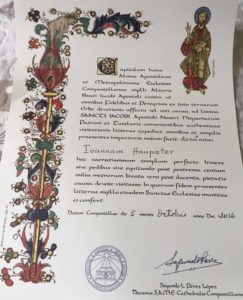
At the top of the list was my visit first thing the next morning to the “pilgrim’s office” where I stood in a long line to show the church official my “pilgrim credencial” (with daily stamps from towns all along the route). Successfully proven, I received a beautiful certificate of completion (called the compostela) in Latin with my first name also written in Latin. It’s definitely a treasured item I’ll be framing very soon.
More About the Santiago Cathedral
The Cathedral offers a pilgrim’s mass” each day at 12noon and 7:30pm along with a pilgrim blessing. A real highlight is the ceremony of the botafumeiro, the high-swinging incense burner operated by 8 red-robed tiraboleiros at the end of the service. This doesn’t happen at every mass but I got lucky at the evening service on my second night. It was very cool!
Afterwards, I went out to dinner with wonderful members of my Camino family (above) for a celebratory farewell dinner (I had seafood paella!) before we all headed home – to Australia, New Zealand, Canada, the US, and South Korea.
Other cool “Cathedral Must Do’s” that I did included passing through the holy gate (Porta Santa), which is only open during Jubilee Years (like this year – the Holy Year of Mercy)! Then, I climbed some steps in a narrow passageway behind the cathedral’s main altar to give a big hug – from behind! – to the statue of Santiago (St. James). Next, it was down to a small crypt below the altar where I paid more respects to St. James, whose relics (along with two of his disciples) are on display (at a distance) in a silver reliquary. Lastly, I took a one-hour tour (in Spanish) of the Cathedral’s roof area – with great views of Santiago!
- Credit: Diego Delso, delso.photo, License CC-BY-SA
- Cathedral roof top tour – with view of the cloister behind me
What Things Surprised You About the Camino?
- The beauty of the landscape. I knew from DJ’s photos (who did her Camino in May) that it would be really pretty but it surpassed my expectations. I really loved all of what I saw – the ever-changing scenery of northern Spain always kept me interested.
- I really loved the actual Camino path itself – its great variety and clever ways it was marked with the yellow arrows, conch shells, and Camino monuments.
- I was a bit surprised at how much “real hiking” there was – like the rocky, sometimes steep paths where you had to carefully watch your step. It kept you focused and in the moment.
- The Camino was much more crowded than I expected. That was not necessarily bad – it meant there were more cool pilgrims to meet. But, my vision of having long periods of time where I had the Camino to myself (with no other people in sight) didn’t really happen.
- I didn’t have as much quiet, reflection time as I pictured. I was often walking with other pilgrims and frequently in interesting conversation. However, I really enjoyed the silent walking periods where I could appreciate the beauty of the landscape and nature all around me.
I was pleasantly surprised at how nice the “pilgrim hostels” were. Many of the private albergues were modern and new. In fact, all of my experiences were good ones.
- I hadn’t realized how many cyclists there would be on the Camino. There were lots – from groups of just two riders to the group of 26 cyclists from Columbia! Sometimes they rode on the main roads and sometimes they shared our paths. We co-existed pretty well.
Lastly, a big question remains. Having now walked the 2nd half of the Camino Frances, I have been asked: Will I go back someday to walk the “1st half” of the Camino (from St. Jean to Sahagun)? Well, my answer at this point is a “definite maybe”! It certainly would be great to see the equally beautiful scenery and towns of that first part. I do know that if I decide to wear my pilgrim backpack again, it would be 2018 at the earliest. Stay tuned…
July 2018 Update: Yes, in fact, I DID return to Spain to successfully walk the Camino’s 1st half (in May/June 2018)! Check out my new blog post all about that wonderful experience including crossing the Pyrenees at the start: Spain Camino #2 – Highlights of Another Grand Pilgrim Adventure.
For More of My Blog Posts on the Camino, Check Out:
- Walking Spain’s Camino – A Journey of the Spirit That Inspires & Transforms
- My Camino: The Magic of Stepping Outside Your Comfort Zone
Comments: What did you think? Would you ever consider walking the Camino? Or have you already done it – what was your experience?











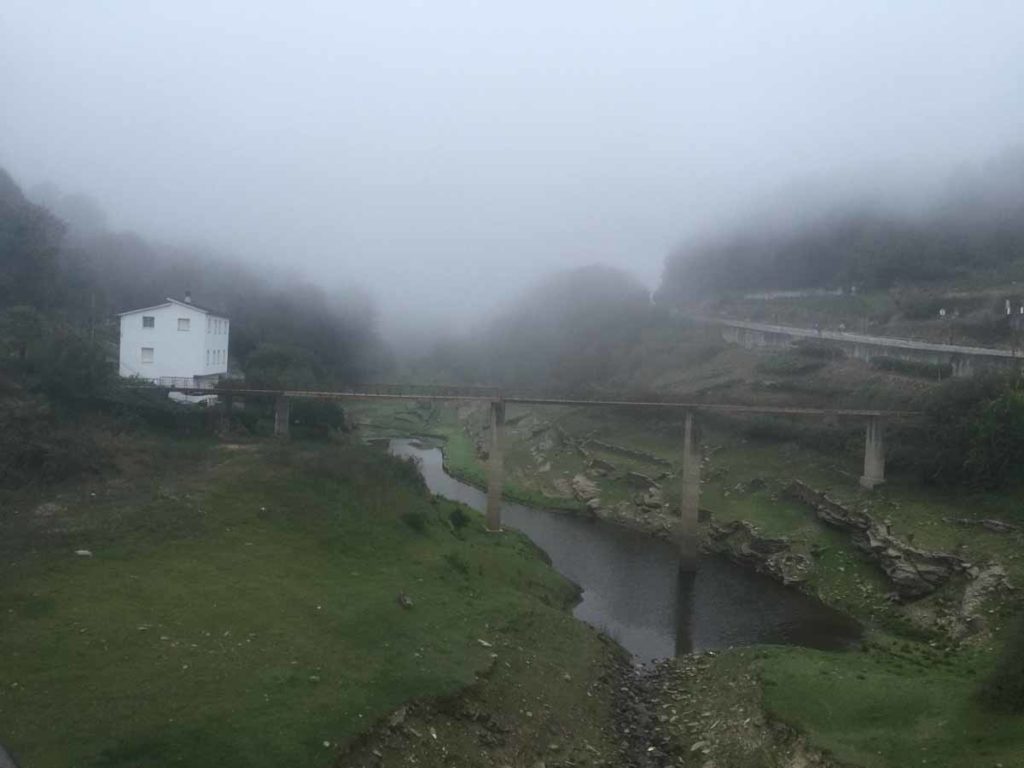


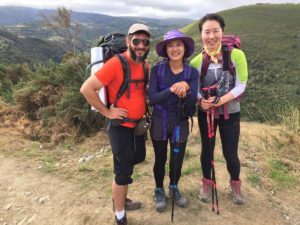
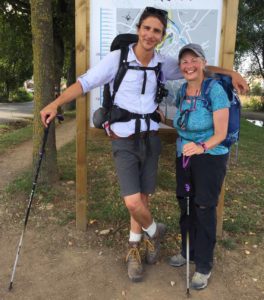

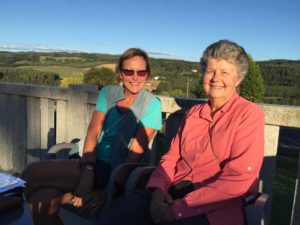



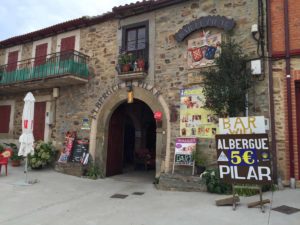





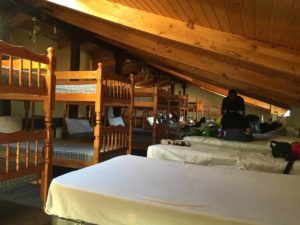



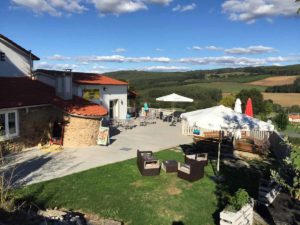









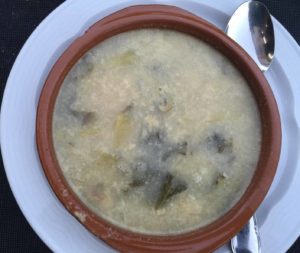

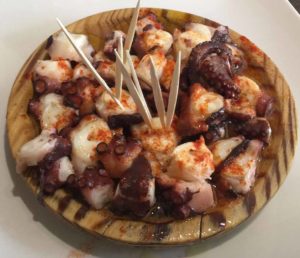










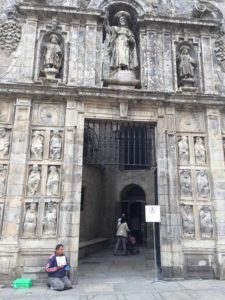


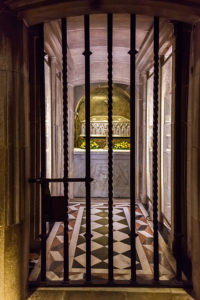

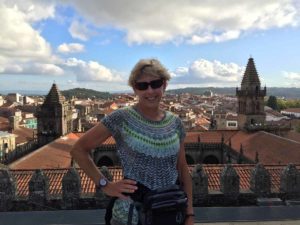



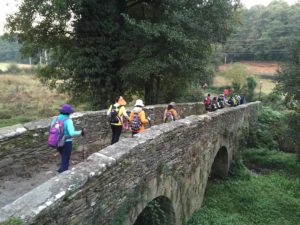




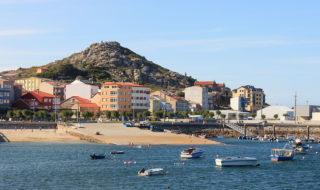

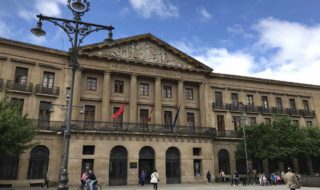
Super job on your oh so interesting journey!
Thank you so much, Rita.
I have loved reading about your trials and tribulations walking the Camino Janet. Thank you for sharing your meaningful and very beautiful journey with us. And a great big Congrats to you!
Thanks so much, Suellen and you’re most welcome. It was my joy sharing this most unusual journey and truly grand adventure with you and others!
Returned from my own Camino October 11th having started in Pamplona on August 30th. Since we were obviously walking at the same time although having never met, I found your blog really engrossing. Of course, I went through all of your pictures to see if we had any friends in common. The middle picture just after you mention the ages of pilgrims was the only one. If I remember correctly her name is Kate from the USA. She was all out of Ibuferen, it was Sunday afternoon in Ponferrada and all the farmacias were closed. I gave her enough of mine to last two days as I had not had any need for them. We then went for dinner together and she treated me to my first taste of tongue. Unfortunately, we never met again
Thank you, Terry. Great to hear from a fellow pilgrim – congratulations on your Camino! Great story about Kate – and yes, she’s the same one you met. I met wonderful Kate, who is from Ohio & Hawaii (and a spunky 70yo), my first night in Sahagun where I was to begin my Camino the next morning. She took me under her wing (as a pro having started in St. Jean) and mentored me, the newbie. We spent three delightful days walking together and staying at the same albergues until Leon where she spent an extra rest day and we parted ways. She arrived in Santiago three days after me.
First, way to go, Janet! I knew you’d make it a great experience for yourself. What a gift to provide us readers with such a thoroughly informative account! I’ll read it all over again if I get to plan this adventure someday. Meanwhile, thanks for an outstanding post. Are you on Instagram? I imagine a hashtag like #planetjanet would get popular fast.
Pat Flanigan
Thanks so much, Pat for your lovely words! I’m so glad you found it helpful, as I know you have interested in possibly being a future pilgrim! Re: Instagram, Thanks! I have just begun on that new social medium (for me) and will soon be starting what I hope might be daily postings of favorite travel photos.
Janet,
Loved the entire stories. I always read your posts with a loving smile as that is how I see you…. happy & excited about life! I am that way and that is one thing I totally love about you. I so look forward to our Antarctica adventure. Thanks for posting & keep up the blogs & living fully!
Love to you XOX Bill
Thanks Bill for your always so kind words! Yes, we have shared so many travel adventures through your BTO photo tours. Excited that Antarctica will be my 7th BTO trip with you and the group, with whom I have traveled the world! I am most grateful for such amazing trips!
Sounds like an awesome adventure. I’ve never even heard of this walk before. My goal is to one day be able to travel like you do and maybe one day even with you. Keep up the fun sharing cause I’m traveling vicariously through you. Adding places to my bucket list.
Thanks so much, Carolyn for your kind words and your encouragement. This really is why I do what I do – to share the world I’ve been blessed to have visited and to help inspire others to do more of the same. If you do get the chance, I think you will really enjoy the movie “The Way” with Martin Sheen which I mention in my first post pre-Camino!
I wish I had known you did the Camino, as it is on our list to do in the next few years and it would have been a great conversation during our many hours at sea. Your blog posts are really helpful and give us a great idea of what to expect. We had originally thought we’d do it this fall, but it might be pushed to the spring of 2018. Any thoughts on doing a spring Camino instead of the fall Camino? We’re thinking of doing the whole thing so many you might want to join us for your other half?
Thanks, Marnie. That’s great about walking the Camino – I know you & Steve will love it! In fact, I am definitely planning to go back in Spring 2018 to do the 1st half. I want to see what I missed. Also, in the next couple months, I am going to be putting together an on-line “master class” for pilgrims-to-be (just like you guys!) who are thinking of / planning to walk their first Camino de Santiago (especially the Camino Frances) – filled with all the many good things to know! I had some wonderful mentors who really prepared me well. And both spring & Fall are good times – just not mid-summer (too hot & too crowded).